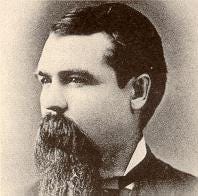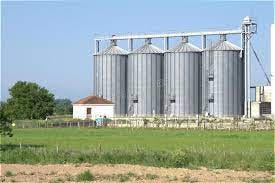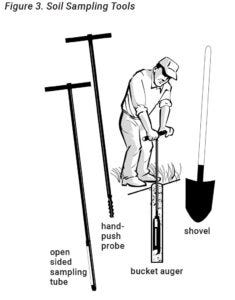When we talk about the major figures in agricultural development, our focus tends to be on researchers in the 20th and 21st centuries. Before that, soil science to that point had existed as it needed to; fundamentals of crop rotation manure, compost, and the basic tools known in agriculture for thousands of years stood as a framework for how farmers related to the soil beneath them. One of the earliest contributors to the development of soil science as a science beyond these basics outlined prior was Franklin Hiram King. His book, “Farmers of Forty Centuries, or Permanent Agriculture in China, Korea, and Japan”, published in 1913 was the antidote to the development of extractive farming practices which had become more common towards the late 19th and early 20th century and was a foundational text for folks like Russell Lord and many of the major players in the permanent agriculture movement of the early 20th century. King’s work flew in the face of science at the time, costing him a career he had spent a lifetime building, but which was imperative in order for him to continue to follow the thread of his research.
There’s little written about King’s personal life; this piece will highlight what exists, and there’s no doubt more scholarship needs to go into exploring more about his background. Because of this, we know little about his politics, his opinions outside of his work, or his family life.
The Beginnings
Born on a farm at La Grange, near Whitewater, Wisconsin on June 8, 1848, only two years and a few hundred miles from where Liberty Hyde Bailey would be born a decade later, who would also go on to change the landscape of American agriculture. King’s childhood resembled many rural kids of that era. Small, local schools in the country provided him with practical education, and he graduated from Whitewater State Normal School in 1872. After graduating, he continued to study when possible under the guidance of one of his teachers, Thomas Chamberlin, but like many young men of the time, found work his first priority.
King taught science for 3 years directly after graduation and began research and writing, including his 1875 paper titled “A Scheme for Plant Analysis”, which, despite his lack of training, was so significant it would later be incorporated into the Ward botanical textbook series. This opened up new opportunities for his career in the sciences, during which he was able to do geological surveys in northern Wisconsin in 1876, and later that year became a student at Cornell University to study the sciences.1 During this time, King was exposed to a wide range of focus areas in the sciences, from working for an ornithologist studying the contents of bird stomachs to soil science. Two years later, King left to become a professor of natural science at River Falls State Normal School in Wisconsin, where he would remain for the following decade.
In 1880, King married Carrie Baker of nearby Berlin, WI. It was her emotional and collaborative support that fed his persistence in research; while at River Falls he had written pioneering research in ornithology, and only a few years later in 1884, King & his wife developed a method of making maps and relief models mechanically, allowing them to produce maps quickly which were sold to schools around the country. At 36 years old, he produced significant research in three different fields of science.
Academia and Beyond
In 1888, only four years later, King was appointed professor of agricultural physics at the University of Wisconsin where coincidentally (or not), his high school teacher Thomas Chamberlin was president. The position was the first of its kind, allowing King to explore exactly what fell under his oversight and follow his interests. It was at this same school that the first soil science courses would be offered in 1889, and King was a central figure in their development.2 King oversaw the development of multiple agricultural courses and stayed busy developing new tools and groundbreaking research for the following decade while also writing a textbook for his students to use in class. The textbook he developed was so popular it spanned six editions.
While King was most focused on soils, his influences outside of soil are still felt today. For example, King led the research behind the development of the cylindrical silo that proved the shape was both stronger and reduced spoilage. He also oversaw the first year-long study of windmills for power generation & led some of the earliest studies on the effects of slope gradient and aspect on the temperatures of fruit tree trunks, which impacts how orchards are now planted across the globe.
King’s focus of his research was primarily on water requirements and tillage. This makes sense, given the timeframe of his research; petrochemical fertilizers were not being applied to fields at a significant scale, and these were the two most impactful areas. His studies provided the foundation for our understanding of water absorption in soils and his invention, the sampling tube, was the precursor to the Vehmeyer sampler, which is used to take core samples on farms today.
His studies correlated increases in yield with irrigation, especially in sandy soils. This, of course, makes sense now because of our understanding of cation exchange, but at the time, it was ground-breaking. His suggestion of increased irrigation, even in humid regions, challenged the conventional science around crop needs. It was during these studies in the 1890s that King began experimenting with “earth mulching” and came to the conclusion that about one-fifth of the water used by well-managed crops was lost from the soil surface, a figure that still is used for humid regions.
King was curious to find out how the roots of a plant impacted how water and nutrients were harvested. He developed new methods for pulling out whole root systems and later brought plants into lab settings to watch how roots absorbed water. Here, he saw how the distribution of the soil materials in the glass columns used to watch the water levels change as the plants absorbed water influenced the rate of water flow. Working alongside Charles E. Slichter, this experiment became the basis for Slichter’s landmark research on the theory of groundwater movement.
As obsessed as he was with soil, its relation to water became just as much of an interest. He studied water tables in relation to any variable— topography, cropping history, other drainage systems, and more. He even had a well with recording equipment installed in the basement of his home. His conclusion was that we could understand water flow through the soil over short distances through calculations, which we can do today. However, long-distance travel would be nearly impossible to calculate, given the diversity of soil structures underground— something that remains a challenge for modern researchers.
Unsurprisingly, as King had begun to amass a wealth of ground-breaking knowledge around soil health, he was quickly on the radar of government officials and was poached in 1901 by the Bureau of Soils in Washington, DC. Excited to have the government support his work and to have access to the tools of power behind him, he continued to dive further into his research, although his time in DC would be short-lived.3
King was hired to lead soil climatology investigations which were already in progress.4 With the resources to back him, he oversaw more research than he could personally handle and recruited a fellow instructor from the University of Wisconsin to join him. Having explored soil health and how water worked through the soil, he carried his new knowledge and interests into researching the way air flow impacted erosion and crop health, as well as how fertilizers impacted different types of soils.
The conclusions they arrived at on the importance of diffusion in gas exchange between the atmosphere and soil have been since better assessed, but these first studies were novel attempts to begin to quantify the relationship between the atmosphere and soil. On the side of soil and plant nutrient composition, King focused on challenging conventional science around the amount of nutrients drawn from soils by plants. The multi-year research project was summarized in 6 manuscripts developed by King. Only three, however, were published.
The other three manuscripts were in fact far more important. In them, King challenged the conventional science, backed by the man who had hired King, Milton Whitney, who was chief of the bureau. Not only did they challenge Whitney’s ideas, they were in direct conflict with recent research published by Whitney two years prior. Whitney’s argument in his paper was that the chemistry of soils is of little or no importance to crop production. He goes as far as to say that the concentration of plant nutrients in the soil is the same in productive and unproductive soils and that all soils fundamentally have enough nutrients for satisfactory plant growth and conclusively those soils had enough nutrients to last indefinitely.
In retrospect, this is a laughable argument about plant and soil science, but it speaks to how revolutionary King’s ideas were at the time. In fact, some reports suggest King had been included as an author of the research at some stage and chose to have his name withdrawn.5 This isn’t surprising, since much of the data was actually collected by King, but was clearly interpreted quite differently by Whitney and the other folks involved in the research. Whitney’s conclusion, since it was not the chemical composition that drove plant growth, was that it was explicitly tied to moisture and temperature— which was also the primary reason he had been interested in King’s work.
King wasn’t the only person to challenge Whitney’s research; soil scientists from across the country and even internationally, such as Sir Edward John Russell, wrote extensively on the poor conclusions made by Whitney’s team. King, however, was an internal instigator who challenged the uniform position of the Bureau, and it was because of this disagreement that King left the Bureau in January 1904, only two years after having joined the staff.
Home
The manuscripts that were not published did not disappear; upon King’s return home, he worked to get them published after getting approval from the Secretary of Agriculture.6 At 50 years old, King decided to focus his efforts on two primary projects after these papers were published; a soil management book and a book on the ventilation of farm buildings and rural schools. All of the research for both of these books had been done, and King’s primary focus was on organizing the information in a way that would be accessible to the general public. There was only one piece of research King was left to do; and that was to travel to Japan, Korea, and China in 1909. King cashed in his life insurance in order to take this trip which would become the keystone of the research that went into his soil management text, which would be the first domino in America’s permanent agriculture movement.
While we don’t know much about the specifics of his trip outside of what exists in the book, upon arriving home, it was his chief concern to finish the book as quickly as possible. His goal for his travels had been to learn about the ways in which the East had maintained long-term soil health for thousands of years— something he knew the United States was running out of time to figure out. In the book, he details his travels and observations throughout Asia focusing primarily on the fields, gardens, and villages themselves, discussing the organized processes of cycling nutrients, including even human manure, which allowed for higher-density populations to exist without the need for significant external inputs.
While the book paints a picture of a sustainable society, King makes note of the fact that even in these systems, erosion was still a problem. The key factor was that farmers spent the time to recycle nutrients that had washed away, primarily through the use of canals organized around farms for dredging.
On the day of King’s death, August 4th, 1911, he was still making final arrangements for the publication of his book, even though the final chapter had not been written. King’s wife Carrie King, after his death, assembled the materials for the chapter and saw the manuscript through publication. Alongside his book a final editorial was released, defending his positions on soil science.
King, like many of those who followed him, found his passion for soil and plant science only comparable to his love for teaching. His teaching was through the classroom and through farmer journals. He managed to write over 130 articles over his career and five books with the goal of making knowledge as accessible as possible. Although he never lived to see his positions accepted as consensus in the scientific community, his work was groundbreaking in the development of our understanding of agriculture today. King’s work was fundamentally a reminder that the new world had much to learn from the old.
If you’ve enjoyed this piece, which is equal to a 10 page chapter, of (so far) a 676 (nice) page book with 316 sources, you can support our work in a number of ways. The first is by sharing this article with folks you think would find it interesting. If you’d like to financially support the project, and get exclusive access to our limited paywalled content, you can become a paid subscriber on Substack or Patreon, which will both give you access to the paywalled content and in the case of Patreon, early access to the audio episodes as well.
Tanner, C. B., and R. W. Simonson. “Franklin Hiram King - Pioneer Scientist.” Soil Science Society of America Journal, vol. 57, no. 1, 1993, pp. 286–292, https://doi.org/10.2136/sssaj1993.03615995005700010049x.
Russell, E.J. 1905. “The recent work of the American Soil Bureau.” J. Agric. Sci (Cambridge) 1:327-346
Gardner, W.H. 1977. Historical Highlights in American soil physics, 1776-1976. Soil Sci. Soc. Am. J. 41:221-229.
Whitney, M. 1901. Report of Chief, Division of Soils. p. 113-140 In 1901 Annu. Rep. USDA, Washington, DC.
Jenny, H. 1961. E.W. Hilgard and the birth of modern soil science. Collana Della Rivista “Agrochimica,” Pisa, Italy. p. 100-101.
King, F.H. Investigations in soil management: E. Influence on farmyard manure upon yield and upon water-soluble salts in soils. F.H. King, Madison, WI.







